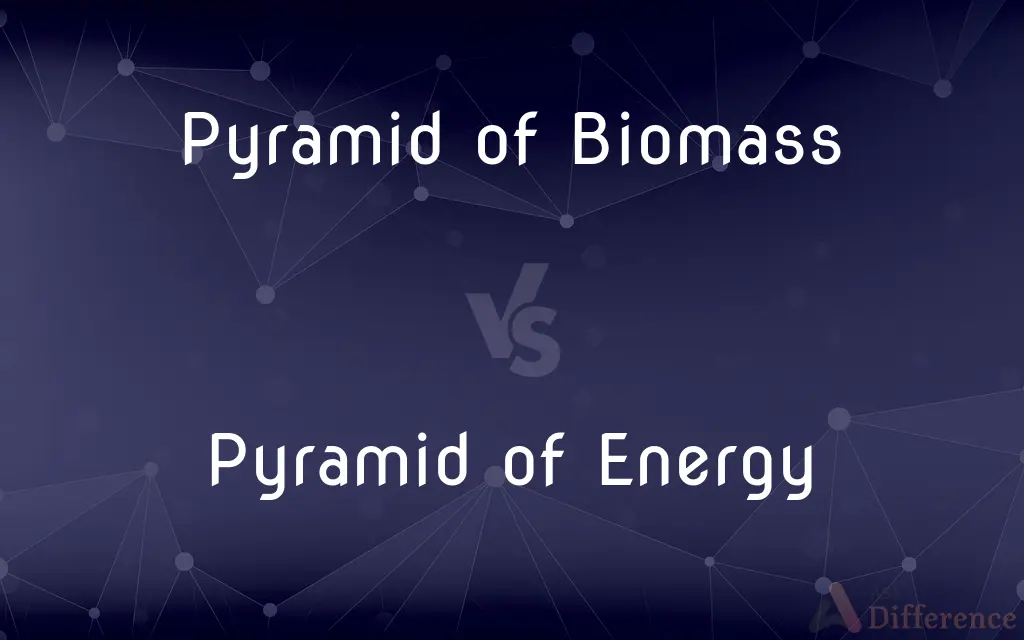Pyramid of Biomass vs. Pyramid of Energy — What's the Difference?
By Tayyaba Rehman — Published on October 18, 2023
Pyramid of Biomass represents the weight of organisms at each trophic level, while Pyramid of Energy displays energy flow between levels. Both illustrate ecosystem dynamics but differ in units and scope.

Difference Between Pyramid of Biomass and Pyramid of Energy
Table of Contents
ADVERTISEMENT
Key Differences
Pyramid of Biomass: This ecological pyramid shows the cumulative weight or volume of living matter at each trophic level in an ecosystem. Typically, plants or producers have the most biomass, and it decreases at higher trophic levels. Pyramid of Energy, however, is concerned with the energy flow.
Pyramid of Energy: This pyramid illustrates the flow and amount of energy moving from one trophic level to the next within an ecosystem. Unlike the Pyramid of Biomass, where biomass can sometimes increase in higher trophic levels, the Pyramid of Energy always shows a decrease as energy is lost primarily as heat.
Comparative Dynamics: The Pyramid of Biomass can occasionally be inverted, for instance, in aquatic ecosystems where phytoplankton have less biomass than zooplankton. Pyramid of Energy, in contrast, is always upright, as energy is continually lost in every transfer.
Units and Measurements: Pyramid of Biomass is typically represented in units like grams per square meter, emphasizing the physical mass or number of organisms. Pyramid of Energy uses units such as kilocalories or joules per square meter per year, highlighting the energy aspect.
Importance: Both pyramids, Biomass and Energy, offer valuable insights into ecosystem health, productivity, and trophic interactions. While Pyramid of Biomass showcases the tangible weight of organisms, Pyramid of Energy depicts the intangible but crucial flow of energy.
ADVERTISEMENT
Comparison Chart
Primary Representation
Cumulative weight or volume of organisms
Flow and amount of energy between trophic levels
Units
Grams/m^2, individuals/m^2
Kilocalories/m^2/year, joules/m^2/year
Typical Shape
Can be upright or inverted
Always upright
Loss Mechanism
Death, waste, inedible parts
Heat, respiration, waste
Relevance
Trophic weight and volume
Energy transfer and efficiency
Compare with Definitions
Pyramid of Biomass
An ecological representation of the weight of living organisms in each trophic level.
In a terrestrial ecosystem, the Pyramid of Biomass typically shows plants having the highest biomass.
Pyramid of Energy
A structured diagram illustrating energy loss and consumption in an ecological system.
Each step up the Pyramid of Energy represents significant energy loss, mainly as heat.
Pyramid of Biomass
A tool showcasing the mass of living material in an ecosystem's trophic levels.
By analyzing the Pyramid of Biomass, ecologists can assess the health of a given habitat.
Pyramid of Energy
A depiction of energy flow across different trophic levels of an ecosystem.
The Pyramid of Energy demonstrates that much of the energy from the sun is lost before reaching top predators.
Pyramid of Biomass
A model used to understand biomass distribution among different trophic interactions.
Changes in the Pyramid of Biomass can indicate disruptions in the food chain.
Pyramid of Energy
A model used for understanding energy dynamics in trophic interactions.
The Pyramid of Energy underscores the inefficiency of energy transfer between trophic levels.
Pyramid of Biomass
A hierarchical structure displaying organismal weight in an ecological community.
The base of the Pyramid of Biomass often represents primary producers, like plants.
Pyramid of Energy
A tool visualizing energy distribution among an ecosystem's organisms.
The base of the Pyramid of Energy typically contains the highest energy, derived from sunlight.
Pyramid of Biomass
A graphical depiction of biomass quantity at different food chain levels.
Researchers were surprised to see an inverted Pyramid of Biomass in certain aquatic systems.
Pyramid of Energy
A representation of energy transfer efficiency in an ecological food chain.
Studying the Pyramid of Energy helps understand why large predators are less numerous.
Common Curiosities
Can the Pyramid of Biomass ever be inverted?
Yes, especially in aquatic ecosystems where smaller producers like phytoplankton might have less biomass than the zooplankton that feed on them.
How does the Pyramid of Energy differ?
The Pyramid of Energy shows the flow and amount of energy moving between trophic levels in an ecosystem.
Why is the Pyramid of Energy always decreasing?
Energy is lost at every trophic level, primarily as heat, making it unavailable to the next level.
What underpins the base of most Pyramid of Biomass?
Primary producers, often plants or phytoplankton, typically form the base.
Is the Pyramid of Energy ever inverted?
No, the Pyramid of Energy is always upright since energy decreases at each subsequent trophic level.
Which pyramid directly relates to the First Law of Thermodynamics?
The Pyramid of Energy, as it showcases energy conservation and loss in an ecosystem.
Is the Pyramid of Energy a better representation of ecosystem dynamics?
While both pyramids offer valuable insights, the Pyramid of Energy more accurately depicts energy flow and loss.
What does the Pyramid of Biomass represent?
The Pyramid of Biomass displays the weight or volume of living organisms at each trophic level in an ecosystem.
Are there any exceptions to the Pyramid of Biomass's shape?
Yes, in some ecosystems like certain aquatic ones, the pyramid can be inverted with smaller producers having less biomass.
How are the units different between the two pyramids?
Pyramid of Biomass uses weight or volume units like grams/m^2, while Pyramid of Energy uses energy units like kilocalories/m^2/year.
Why are these pyramids important?
Both pyramids provide insights into ecosystem health, productivity, and trophic interactions.
Can a Pyramid of Biomass help determine ecosystem health?
Yes, significant changes in biomass at any level can indicate disturbances or changes in the ecosystem.
Is energy ever lost in the Pyramid of Biomass?
While the Pyramid of Biomass focuses on weight or volume, energy is inherently lost in the system as organisms use it, but this is more explicitly represented in the Pyramid of Energy.
Why are top predators so energy inefficient?
Due to the loss of energy at each trophic level in the Pyramid of Energy, top predators receive only a tiny fraction of the energy that originally entered the ecosystem.
Can studying the Pyramid of Energy help with conservation?
Yes, understanding energy dynamics can aid in managing and conserving ecosystems more effectively.
Share Your Discovery

Previous Comparison
LCD TV vs. LED TV
Next Comparison
Resilience vs. FlexibilityAuthor Spotlight
Written by
Tayyaba RehmanTayyaba Rehman is a distinguished writer, currently serving as a primary contributor to askdifference.com. As a researcher in semantics and etymology, Tayyaba's passion for the complexity of languages and their distinctions has found a perfect home on the platform. Tayyaba delves into the intricacies of language, distinguishing between commonly confused words and phrases, thereby providing clarity for readers worldwide.
















































